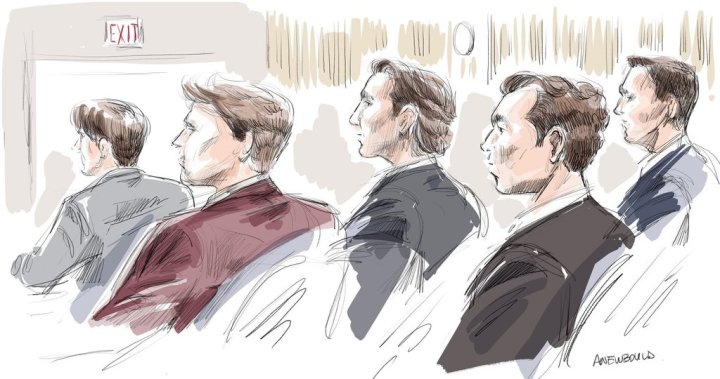Uncategorized
Crown continues closing submissions in world junior sex assault trial

Prosecutors are expected to continue their closing submissions Thursday at the sexual assault trial of five former members of Canada’s world junior hockey team.
Prosecutor Meaghan Cunningham argued Wednesday that Michael McLeod invited his teammates into his London, Ont., hotel room for group sexual activity without the complainant’s knowledge or consent, which she said paints the evidence of all other witnesses in “a very different light.”

Get daily National news
Get the day’s top news, political, economic, and current affairs headlines, delivered to your inbox once a day.
Cunningham argued the woman did not voluntarily agree to the sexual acts that took place in the early morning hours of June 19, 2018, nor did the players take reasonable steps to confirm her consent.
Consent is a central issue in the trial, which began in late April.
Michael McLeod, Carter Hart, Alex Formenton, Dillon Dube, and Callan Foote have pleaded not guilty to sexual assault, while McLeod has also pleaded not guilty to an additional charge of being a party to the offence of sexual assault.
Defence lawyers made their submissions to the judge earlier this week, taking aim at the complainant’s credibility and reliability as a witness and arguing she actively participated in the sexual activity that night.
© 2025 The Canadian Press
Uncategorized
Blue Jays reinstate Gimenez from injured list

TORONTO – The Toronto Blue Jays reinstated second baseman Andres Gimenez from the 10-day injured list Tuesday and designated infielder Buddy Kennedy for assignment.
Gimenez, a three-time Gold Glove award winner, missed five weeks with a left ankle sprain.
Related Videos
The moves were announced shortly before the Blue Jays opened a three-game series against the visiting Chicago Cubs.
Entering play Tuesday night, Gimenez had five homers, 23 RBIs and a .218 average.

Get daily National news
Get the day’s top news, political, economic, and current affairs headlines, delivered to your inbox once a day.
Kennedy had one hit in two games for the Blue Jays. He also played four games for the Philadelphia Phillies earlier this season.
This report by The Canadian Press was first published Aug. 12, 2025.
© 2025 The Canadian Press
Uncategorized
Man dead, another in custody after stabbing in Toronto’s east end


Around 2:30 p.m., Toronto police said they were called to the area of Woodbine and Duvernet avenues for reports someone had been stabbed inside a neighbouring home.
Source link
Uncategorized
Jays’ Shapiro says he wants to remain with team

TORONTO – Blue Jays president Mark Shapiro declined to comment on contract extension talks Tuesday but said he wants to remain with the club and that team ownership has been “reciprocal in that desire.”
Shapiro, who also serves as chief executive officer, is in the final year of his contract.
“When I think about alternatives, I’ve never been a grass is greener guy,” he said in a pre-game availability. “Twenty-four years in one place in Cleveland and 10 years here now.
Related Videos
“So it’s the appreciation for what I have and the people that I get to work with every day, the city that I work in and the country that I live in, those things are drivers for me to remain here.”
Shapiro, 58, joined the club in 2015 and signed a five-year extension in January 2021.

Get daily National news
Get the day’s top news, political, economic, and current affairs headlines, delivered to your inbox once a day.
He took questions from reporters for about 20 minutes in a rare in-season media session. Shapiro was asked directly whether there had been discussions with team owner Rogers Communications on a new deal.
“Sure, yeah, I mean I think (it’s) not appropriate for me to comment beyond the fact that what I just said is I want to remain here,” Shapiro said. “And I can also say that both (Rogers executive chair) Edward (Rogers) and (Rogers president/CEO) Tony (Staffieri) have been reciprocal in that desire.”
It has been a worst-to-first campaign for Canada’s lone Major League Baseball team. The Blue Jays finished last in the American League East division standings last season but have enjoyed a stellar season in 2025.
Toronto entered Tuesday night’s game against the visiting Chicago Cubs with the best record in the AL at 69-50.
This report by The Canadian Press was first published Aug. 12, 2025.
© 2025 The Canadian Press
-

 Uncategorized2 months ago
Uncategorized2 months agoAccording to Dior Couture, this taboo fashion accessory is back
-

 Uncategorized2 months ago
Uncategorized2 months agoThese ’90s fashion trends are making a comeback in 2017
-

 Uncategorized2 months ago
Uncategorized2 months agoThe old and New Edition cast comes together to perform
-

 Uncategorized2 months ago
Uncategorized2 months agoUber and Lyft are finally available in all of New York State
-

 Uncategorized2 months ago
Uncategorized2 months agoNew Season 8 Walking Dead trailer flashes forward in time
-

 Uncategorized2 months ago
Uncategorized2 months agoMeet Superman’s grandfather in new trailer for Krypton
-

 Uncategorized2 months ago
Uncategorized2 months ago6 Stunning new co-working spaces around the globe
-

 Uncategorized2 months ago
Uncategorized2 months agoThe final 6 ‘Game of Thrones’ episodes might feel like a full season







